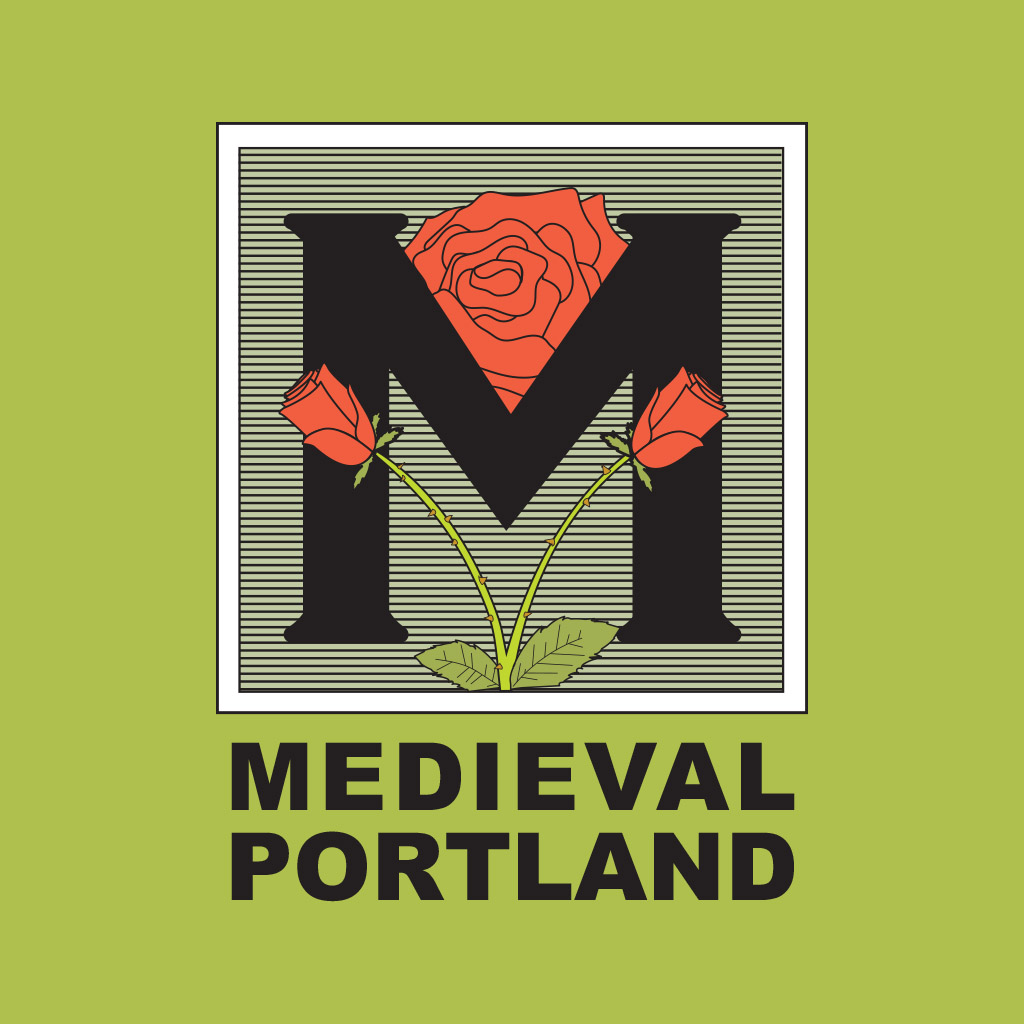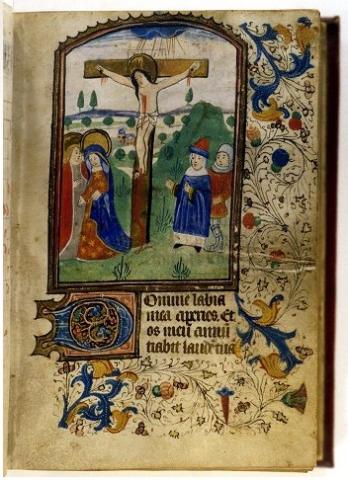Book of Hours, Use of Tournai
Book of Hours, Use of Tournai
French, 2nd quarter 15th century
Master of the Gold Scrolls Group
Fol.15r: Crucifixion
Language: Latin, French
vellum (parchment)
height 15.8 centimeters
width 11 centimeters
113 leaves (15.8 X 11.0 cm). Pointed Gothic script and bâtard. 16 lines. Gatherings mostly of 8, some miniatures tipped in. Text in Latin and French: Calendar, Hours of the Cross, of the Holy Spirit, of the Virgin, Psalms, Litany, Prayers to Male Saints, Office of the Dead, 15 Joys of the Virgin, 7 Requests, Prayers to Female Saints, Gospel Lessons, Hymn to Stella Maris. 5 large and 8 small miniatures. Binding: red calf, 19th c. Slip cased.
Provenance: Marie Francois Treau, 1678 (inscription); Madame van Huerne de Puyenbeke, née de Schietere de Lophem (ex libris); Charles McCuIloch.
Publication: Parshall 6, p. 18
Willamette University, Mark O. Hatfield Library Special Collections: BX2080.P7 1400
Parshall, Peter. Illuminated Manuscripts from Portland Area Collections. Portland, OR: Portland Art Museum, 1978, p. 18 - Quoted with permission
During the first half of the fifteenth-century manuscript illumination in the southern Netherlands was dominated by various local centers. One of the most influential has been identified with the workshop of the so-called Master of the Golden Scrolls. Many Books of Hours done in this manner were written for the major diocese of Tournai. The Willamette Hours, judging from its landscape and figure compositions, the bud-like mouths and dark, currant eyes, the cusped frames, and acanthus borders, certainly falls into this category. But these formal features have been abstracted into an awkward, stylized idiom more reminiscent of a folk-art tradition than the preciousness that one generally associates with book illumination. The incidence of rather fully decorated books of such provincial quality indicates the growing popularity of Books of Hours in the lively and mobile commercial society of Flanders. The number of miniatures and use of gold leaf--more quantifiable dimensions of value--took precedence over the subtlety with which a painter translated the style of his models. Manuscripts of this sort are rarely exhibited, yet they have much to tell us about the process of stylistic diffusion and shifting value judgment occurring within a single culture.
Miranda Besa, Medieval Portland Senior Capstone Student, 2012
This Flemish Book of Hours is an intact manuscript that was produced in the 15th century. It consists of 113 leaves, made of vellum, and the text is written in Latin and French using Pointed Gothic and Bastard script.[1] This book contains: a Calendar, the Hours of the Cross, the Hours of the Holy Spirit, the Hours of the Virgin, Penitential Psalms, Litany of the Saints, Suffrages of Male Saints, Obsecro Te, O Intemerata, Suffrage of St Sebastian, Suffrages of the Female Saints, Office of the Dead, 15 Joys of the Virgin, 7 Requests to our Lord, Gospel Lessons, O Domine and a Hymn to Stella Maris and is comparable to what is found in other Horae produced during the fifteenth century.[2]
The text in this book is written in red and black ink. The majority of the large decorative initials, used to designate the beginning of a new section or to indicate a passage of importance, are illuminated in red, blue, and gold paint. The large illuminated letters found in the Gospel Lessons indicate that these prayers were added on after the original work was done. The illuminated letters in this section were created using only blue and gold paint and are simpler than the initials found in the previous prayers. It is unusual that the Gospel Lessons had to be added to this manuscript because, during this time period, they were routinely included in the manuscripts following the Calendar.[3] Bastard Script is used for the O Domine and the Hymn to Stella Maris prayers, whereas the rest of the prayers are composed of pointed Gothic Script. In addition, Hymn to Stella Maris's large initial letters use only red ink and O Domine is written exclusively in black ink.
This manuscript has 13 miniatures, 5 large and 8 small, depicting: Crucifixion, Pentecost, Annunciation, Last Judgment, St. Nicholas, St. Anthony, Pieta, St. Sebastian, St Barbara, St. Agatha, St. Catherine, a funeral, and Virgin and Child. The miniatures in this manuscript can be identified as the work of illuminators from the Master of the Golden Scrolls group.[4] This was a large workshop, based in Bruges that created many books of hours for mass distribution.[5] Illuminators from this group were known for their acanthus borders, cusped frames, and the doll-like figures in their work.[6] The five large miniatures in this manuscript all have an acanthus border with blue, gold, and red. The people depicted in all of the miniatures are unembellished, doll-like, and quite similar to one another. There is a striking similarity between the Last Judgment at the beginning of the Penitential Psalms in this manuscript and the one found in the Walters Art Museum, MS W. 245, which is attributed to an artist of the Gold Scrolls group.[7] This miniature depicts Christ sitting on a rainbow, with seraphim trumpeting the dead whose faces are emerging from the ground.[8] It is this similarity between these two images that compellingly indicate that the artists in this book are from the Gold Scrolls group and a further indication that this particular image was used extensively in Books of Hours produced in Belgium during the 15th century. Belgium at that point was one of the only regions still using this image, whereas images of David were being used in more frequency, for the Penitential Psalms, everywhere else.[9]
The simpler qualities of the pictures in this manuscript indicate that this was a mass-produced work that became common in the mid-15th century. As book makers began mass producing Books of Hours more people had the ability to afford them, but it was still an expensive purchase. These books were cherished by their owners and this devotion is clearly demonstrated in this prayer book by an inscription, in French, on verso of leaf [2] that reads: "This book belongs to Marie Francois Treau, who begs anyone who finds it to return it to her for god or for money. 1678."[10] This book of hours was known to be owned by at least two women; Marie Francois Treau and Madame van Huerne de Puyenbeke, the latter whose name is imprinted on the inside of the 19th-century calfskin cover. Although it is not clear how Charles Mcculloch obtained the manuscript, it is generally accepted that he is the one who donated it to Willamette University where it has resided since the 1940s or 50s.[11]
Notes
[1] Peter W. Parshall Illuminated Manuscripts from Portland Area Collections (Portland: Portland Art Museum, 1978), 18.
[2] Roger S Wieck Time Sanctified (New York: George Braziller, Inc., 2001), 28.
[3] Roger S Wieck Time Sanctified (New York: George Braziller, Inc., 2001), 55.
[4] Peter W. Parshall Illuminated Manuscripts from Portland Area Collections (Portland: Portland Art Museum, 1978), 18.
[5] Roger S Wieck Time Sanctified (New York: George Braziller, Inc., 2001), 30.
[6] Peter W. Parshall Illuminated Manuscripts from Portland Area Collections (Portland: Portland Art Museum, 1978), 18.
[7] Roger S Wieck Time Sanctified (New York: George Braziller, Inc., 2001), 97.
[8] Roger S Wieck Time Sanctified (New York: George Braziller, Inc., 2001), 98.
[9] Roger S Wieck Time Sanctified (New York: George Braziller, Inc., 2001), 97.
[10] Adele Birnbaum, "From the Library Vault A Book to Elevate the Soul," Willamette Scene Annual Report, (November 1972), 3. http://www.willamette.edu/~dsimonse/Willamette Scene BOH 1972 PDF-1.pdf (accessed July 25, 2012).
[11] Adele Birnbaum, "From the Library Vault A Book to Elevate the Soul," Willamette Scene Annual Report, (November 1972), 3. http://www.willamette.edu/~dsimonse/Willamette Scene BOH 1972 PDF-1.pdf (accessed July 25, 2012).
Bibliography
Birnbaum, Adele. "From the Library Vault A Book to Elevate the Soul." Willamette Scene Annual Report, November 1972. http://www.willamette.edu/~dsimonse/Willamette Scene BOH 1972 PDF-1.pdf (accessed July 25, 2012).
Farquhar, James D. "Manuscript Production and Evidence for Localizing and Dating Fifteenth-Century Books of Hours: Walters Ms. 239." The Journal of the Walters Art Gallery 45, (1987): 44-88. http://www.jstor.org/stable/20169032 (Jul 7, 2012).
Freeman, Margaret B. "A Book of Hours Made for the Duke of Berry." The Metropolitan Museum of Art Bulletin 15, no.4 (Dec. 1956): 93-104. http://www.jstor.org/stable/3257709 (Jul 7, 2012).
McC. McK., W. "Early English Manuscript Drawings and a Flemish Book of Hours." The Art Institute of Chicago 17, no.9 (Dec. 1923): 106-108. http://www.jstor.org/stable/4116689 (Jul 7, 2012).
Parshall, Peter W. Illuminated Manuscripts from Portland Area Collections. Portland: Portland Art Museum, 1978.
Orth, Myra D. "Antwerp Mannerist Model Drawings in French Renaissance Books of Hours: A Case Study of the 1520s Hours Workshop." The Journal of the Walters Art Gallery 47, (1989): 61-75, 77-90. http://www.jstor.org/stable/20169052 (Jul 7, 2012).
Warren, Jason Scott. "Reading Graffiti in the Early Modern Book." Huntington Library Quarterly 73, no.3 (Sept. 2010): 363-381. http://www.jstor.org/stable/10.1525/hlq.2010.73.3.363 (Jul 7, 2012).
Watson, Rowan. Illuminated Manuscripts and Their Makers. London: V & A Publications, 2003.
Wieck, Roger S. Time Sanctified. New York: George Braziller, Inc., 2001.

